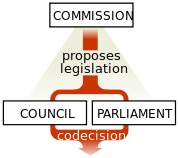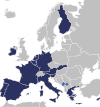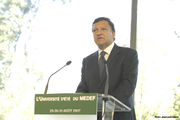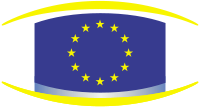President of the European Commission
| President of the European Commission |
|
|---|---|
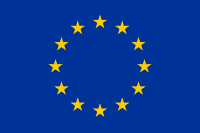 Commission emblem (EU flag) |
|
| Nominator | European Council[1] |
| Appointer | European Parliament |
| Term length | 5 years, renewable once |
| Inaugural holder | Walter Hallstein |
| Formation | 1 January 1958 |
| Deputy | Catherine Ashton |
| Salary | €24,422.80 per month |
| Website | ec.europa.eu/president |
The President of the European Commission is the head of the European Commission ― the executive branch of the European Union (EU) ― is the most powerful office in the EU.[2] The President is responsible for allocating portfolios to members of the Commission and can reshuffle or fire them if needed. He determines the Commission's policy agenda and all the legislative proposals it produces (the Commission is the only body that can propose EU laws).
The Commission President also represents the EU abroad, although he does this alongside the President of the European Council and the High Representative (which sit in his Commission). However the President, unlike a normal head of government, does not form foreign policy, command troops or raise taxes as these are largely outside the remit of the EU.
The post was established in 1958 and is appointed by the European Council and European Parliament for five year terms. Once elected, he, along with his Commission, is responsible to Parliament which can censure him. The current President is José Manuel Barroso, who took office in October 2004. He is a member of the European People's Party (EPP) and is the former Prime Minister of Portugal. Barroso is the eleventh President and in 2009 was re-elected for a further five years. His vice president, as of 2010, is High Representative Catherine Ashton.
Contents |
History
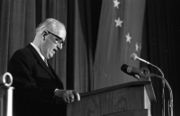
| European Union |
 This article is part of the series: |
|
Policies and issues
|
|
Foreign relations
|
The President of the European Commission was established in 1957 with the European Commission. Previously it was merely a post of first among equals but had an increasing impact on the Community. Under Jacques Delors it became increasingly presidential in style and now is the dominant force in the Commission, although curbed by crises such as the resignation of the Santer Commission.
Establishment
Before the establishment of the present European Commission, there was the High Authority of the European Coal and Steel Community. In 1957 the present Commission was established by the Treaty of Rome, and it also replaced the High Authority and the Commission of Euratom in 1967.[3] The Commission's first president was Walter Hallstein (see Hallstein Commission) who's started consolidating European law and began to impact on national legislation. National governments took little heed of his administration at first with the President having to stamp the Commission's authority early on. With the aid of the European Court of Justice the Commission began to be taken more seriously.[4]
In 1965 Hallstein put forward his proposals for the Common Agricultural Policy, which would give the Community its own financial resources while giving more power to the Commission and Parliament and removing the veto power over Agriculture in the Council. These proposals led to an immediate backlash from France.[5] Hallstein knew the proposals would be contentious, and took personal charge of drafting them, overriding the Agriculture Commissioner. However he did gain the support of Parliament through his proposals to increase its powers, and he also presented his policy to Parliament a week before he submitted them to the Council. He aimed to demonstrate how he thought the Community ought to be run, in the hopes of generating a wave of pro-Europeanism big enough to get past the objections of member states. However in this it proved that, despite its past successes, Hallstein was overconfident in his risky proposals.[6]
In reaction to Hallstein's proposals and actions, then-French President, Charles de Gaulle, who was sceptical of the rising supranational power of the Commission, accused Hallstein of acting as if he were a head of state. France eventually withdrew its representative from the Council, triggering the notorious "empty chair crisis".[5] Although this was resolved under the "Luxembourg compromise", Hallstein became the scapegoat for the crisis. The Council refused to renew his term, despite being the most 'dynamic' leader until Jacques Delors.[6]
1967-85
Hallstein's work did enable the Commission to be a real player. During the 1970s the Presidents were involved in the major political projects of the day, such as the European Monetary Union.[7] In 1970, President Jean Rey secured the Community's own financial resources[8] and in 1977, President Roy Jenkins became the first Commission President to attend a G7 summit on behalf of the Community.[9]
However due to problems such as the 1973 oil crisis and the 1979 energy crisis, economic hardship put the European ideal on the back burner, with only the President trying to keep the idea alive. The member states had the upper hand and they created the European Council to discuss topical problems, yet the Council was unable to keep the major projects on track such as the Common Agricultural Policy.[10] The Community entered a period of eurosclerosis due to economic difficulties and disagreements on the Community budget, and by the Thorn Commission the President was unable to exert his influence to any significant extent.[11]
Presidentialism
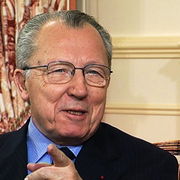
However the Commission began to recover under President Jacques Delors' Commission. He is seen as the most successful President, being credited with giving the Community a sense of direction and dynamism.[12] The International Herald Tribune noted the work of Delors at the end of his second term in 1992: "Mr. Delors rescued the European Community from the doldrums. He arrived when Europessimism was at its worst. Although he was a little-known former French finance minister, he breathed life and hope into the EC and into the dispirited Brussels Commission. In his first term, from 1985 to 1988, he rallied Europe to the call of the single market, and when appointed to a second term he began urging Europeans toward the far more ambitious goals of economic, monetary and political union."[13]
But Delors not only turned the Community around, he signaled a change in the Presidency. Before he came to power the Commission President still was a position of first among equals, when he left office he was the undisputed icon and leader of the Community. His tenure had produced a strong Presidency and a strong Commission as the President became more important. Following treaties cemented this change, with the President being given control over the allocation of portfolios and being able to force the resignation of Commissioners. When President Romano Prodi took office with the new powers of the Treaty of Amsterdam, he was dubbed by the press as Europe's first Prime Minister.[14][15] President Delors' work had increased the powers of Parliament, whose support he had enjoyed. However, later Commissions did not enjoy the same support and in 1999 parliament used its powers to force the Santer Commission to resign.[16]
Parliamentary oversight
Historically, the Council appointed the Commission President and the whole body by unanimity without input from Parliament. However with the Treaty on European Union in 1993, Parliament gained the right to be 'consulted' on the appointment of the President and to veto the Commission as a whole. Parliament decided to interpret its right to be consulted as a right to veto the President, which the Council reluctantly accepted[17] This right of veto was formalised in the Amsterdam Treaty. The Treaty of Nice changed the Council's vote from a unanimous choice to one that merely needed a qualified majority. This meant that the weight of the Parliament in the process increased resulting in a quasi-parliamentary system where one group could be 'in government'. This became evident in 2004 when numerous candidates were put forward and a centre-right vote won out over left wing groups and France & Germany.[18] Barroso was then forced to back down over his choice of Commissioners due to Parliament's threat that it would not approve his Commission.[19]
Appointment
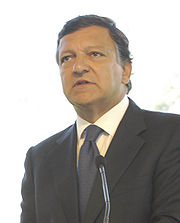
Article 17 of the Treaty on European Union, as amended by the Treaty of Lisbon, lays out the procedure for appointing the President and his team. The Council (as the European Council) vote by qualified majority for a nominee for the post of President after taking account of the latest European elections. This proposal is then put before Parliament which must approve or veto the appointment. The President then, together with the Council, puts forward his team to the Parliament to be scrutinised. The Parliament then votes on the Commission as a whole and, if approved, the Council acting by a qualified majority appoints the President and his team to office.[20]
Transparency
Qualified majority in the Council has led to more candidates being fielded while there has been greater politicisation due to the involvement of Parliament and the change of policy direction in the EU from the creation of the single market to reform of it.[21] However despite this, the choice within the Council remains largely behind closed doors. During the appointment of Santer, discussions were kept in private with the media relying on insider leaks. MEPs were angry with the process, against the spirit of consultation that the new EU treaty brought in. Pauline Green MEP, leader of the Socialist group, stated that her group thought "Parliament should refuse to condone a practice which so sullies the democratic process".[22] There was similar deals in 1999 and 2004 saw a repeat of Santer's appointment when Barroso was appointed through a series of secret meetings between leaders with no press releases on the negotiations being released.[23] This was sharply criticised by MEPs such as the liberal group leader Graham Watson who described the procedure as a "Justus Lipsius carpet market" producing only the "lowest common denominator"; while Green-EFA co-leader Daniel Cohn-Bendit asked Barroso after his first speech "If you are the best candidate, why were you not the first?"[24][25]
Criteria
The candidate selected by the Council has often been a leading national politician but this is not a requirement. The choice of President must take into account the result of the latest Parliamentary elections (i.e. the candidate supported by the victorious European political party in particular, or at least someone from that political family). That provision was not in force in the nomination in 2004, but the centre-right European People's Party (EPP) who won the elections pressured for a candidate from its own ranks. In the end, the EPP candidate was chosen: José Manuel Barroso.[26] On the same basis, the EPP endorsed again Barroso for a second term during the 2009 European elections campaign and, after winning again the elections, was able to secure his nomination by the European Council.
Further criteria seen to be influencing the choice of the Council include: which area of Europe the candidate comes from, favoured as Southern Europe in 2004; the candidate's political influence, credible yet not overpowering members; language, proficiency in French considered necessary by France; and degree of integration, their state being a member of both the eurozone and the Schengen Agreement.[27][28][29]
There is an assumption that there is a rolling agreement along these lines that a president from a large state is followed by a president from a small state, and one from the political left will be followed by one from the political right: Roy Jenkins (British socialist) was followed by Gaston Thorn (Luxembourg liberal), Jacques Delors (French socialist), Jacques Santer (Luxembourg Christian democrat), Romano Prodi (Italian left wing Christian democrat) and Jose Barroso (Portuguese Christian democrat). However, despite these assumptions these Presidents have usually been chosen during political battles and coalition building. Delors was chosen following a Franco-British disagreement over Claude Cheysson, Santer was a compromise after Britain vetoes Jean-Luc Dehaene and Prodi was backed by a coalition of thirteen states against the Franco-German preference for Guy Verhofstadt.[30]
Elections
In February 2008, President Barroso admitted there was a problem in legitimacy and that, despite having the same legitimacy as Prime Ministers in theory, in practice it was not the case. The low voter turnout creates a problem for the President's legitimacy, with the lack of a "European political sphere", but analysis claim that if citizens were voting for a list of candidates for the post of President, turn out would be much higher than that seen in recent years.[31]
Under the Treaty of Lisbon the European Council has to take into account the results of the latest European elections and, furthermore, the Parliament "elects", rather than simply approve, the Council's proposed candidate. This was taken as the parliament's cue to have its parties run with candidates for the President of the Commission with the candidate of the winning party being proposed by the Council.[32] This was partly put into practice in 2004 when the European Council selected a candidate from the political party which secured a plurality of votes in that year's election. However at that time only one party had run with a specific candidate: the European Green Party, who had the first true pan-European political party with a common campaign,[33] put forward Daniel Cohn-Bendit.[32] However the fractious nature of the other political parties led to no other candidates, the People's Party only mentioned four or five people they'd like to be President.[34]
There are plans to strengthen the European political parties[35] in order for them to propose candidate for future elections.[36][37] The European Liberal Democrat and Reform Party indicated, in their October 2007 congress, their intention to forward a candidate for the post as part of a common campaign but failed to do so.[38]
Term of office
The President is elected for a renewable five year term starting six months after the elections to the European Parliament. These were brought into alignment via the Maastricht Treaty and the elections take place in June every five years (the first election was held in 1979, hence all subsequent elections are held on years ending in 4 and 9).[39] This alignment has led to a closer relationship between the elections and the President himself with the above mentioned proposals for political parties running with candidates.
The President and his Commission may be removed from office by a vote of censure from Parliament. Parliament has never done this to date, however the threat of this happening in 1999 due to allegations of financial mismanagement led to the Santer Commission resigning on its own accord, before the Parliament forced them out.[40]
In the Treaty of Lisbon, the European Council can end the President's term of office in the event of an impediment or serious misconduct (article 9B (5)).
Duties and powers
The President of the European Commission is the most powerful position in the European Union,[2] controlling the Commission which collectively has a monopoly on all Union legislation and is responsible for ensuring it is enforced.[2][41] The President controls the policy agenda of the Commission for his term and in practice no policy can be proposed without the President's agreement.[2]
The role of the President is to lead the Commission, and give direction to the Commission and the Union as a whole. The treaties state that "the Commission shall work under the political guidance of its President" (Article 219 TEC), this is conducted through his calling and chairing of meetings of the college of Commissioners,[39] his personal cabinet and the meetings of the heads of each commissioner's cabinet (the Hebdo).[2][39] The president may also force a Commissioner to resign.[39] The work of the Commission as a body is based on the principle of Cabinet collective responsibility, however in his powers he acts as more than a first among equals.[39] The role of the President is similar to that of a national Prime Minister chairing a cabinet.[2]
The President also has responsibility for representing the Commission in the Union and beyond. For example, he is a member of the European Council and takes part in debates in Parliament and the Council of Ministers. Outside the Union he attends the meetings of the G8 to represent the Union.[39] However in foreign affairs, he does have to compete with several Commissioners with foreign affairs related portfolios: the High Representative for the Common Foreign and Security Policy and the President of the European Council.[42]
The Presidential system had started to develop since Jacques Delors and has since been cemented, a strong President with competent mandarins is practically unstoppable. However, externally he is still dependent on support from the Council and Parliament. Delors had enjoyed the Parliament's and the Council's support for his whole term, and due to his work the Parliament increased in powers and the Council increased in membership. The membership is now so large the President is increasingly unable to garner the support of all the states, even though the job is supposed to try to keep everyone happy. The Parliament now has more powers over the Commission and can reject its proposals, although the Commission has little power over Parliament, such as the ability to dissolve it to call new elections.[43]
The Presidents office is on the top, 13th, floor of the Berlaymont building in Brussels. The president receives his political guidance from his cabinet, the head of which acts as a political bodyguard for the President. Such factors can lead to an isolation of the President from outside events.[44] For the European Civil Service the President has a status akin to a deity, due to his immense authority and symbolism within the body.[45] The President exercises further authority through the legal service and Secretariat-General of the Commission. The former has the power to strike down proposals on legal technicalities while the latter organises meetings, agendas and minutes. His control over these areas gives the President further political tools when directing the work of the Commission. This has also increased the Presidential style of the Commission President.[46]
With the reorganisation of leading EU posts under the Lisbon Treaty, there was some criticism of each posts vague responsibilities. Ukrainian ambassador to the EU Andriy Veselovsky praised the framework and clarified it in his own terms: The Commission President speaks as the EU's "government" while the President of the European Council is a "strategist". The High Representative specialises in "bilateral relations" while the European Commissioner for Enlargement and European Neighbourhood Policy deals in technical matters such as the free trade agreement with Ukraine. The President of the European Parliament meanwhile articulates the EU's values.[47]
Relationship to European Council Presidency
Despite the recent Presidential style, the President has also begun to lose ground to the larger member states as countries such as France, Italy, the UK and Germany seek to sideline its role. This may increase with the recent creation of the permanent President of the European Council.[48] There has been disagreement and concern over competition between the President of the European Council Van Rompuy and the Commission President Barroso due to the vague language of the treaty. Some clarifications see Van Rompuy as the "strategist" and Barroso as a head of government. In terms of economic planning Van Rompuy saw the Commission as dealing with the content of the plan and the European Council as dealing with the means and implementing it. Despite weekly breakfasts together there is a certain extent of rivalry between the two yet-defined posts, including the High Representative.[47][49][50]
Although there are concerns that competition with the new Council President would lead to increased infighting,[51] there are provisions for combining the two offices. The European Council President may not hold a national office, such as a Prime Minister of a member state, but there is no such restraint on European offices. So the Commission President, who already sits in the European Council, could also be appointed as its President. This would allow the European Council to combine the position, with its powers, of both executive bodies into a single President of the European Union.[52]
Since the creation of the European Council presidency, President Van Rompuy and Commission President Barroso have begun to compete with each other as Van Rompuy has benefited from the general shift in power from the Commission to the Council yet with Barroso still holding the real powers. At international summits there was no agreement as to who should represent the EU, so they agreed to both go at the same time. The complicated situation has renewed some calls to merge the posts, possibly at the end of Barroso's term in 2014 or even as early as mid-2012 when Van Rompuy's present mandate ends. However some member states are expected to oppose the creation of such a high profile post.[50][49]
Privileges of office
The basic monthly salary of the President is fixed at 138% of the top civil service grade[53] which works out at €24,422.80.[54] Vice Presidents are paid €22,122.10, ordinary commissioners €19,909.89 and the High Representative €23,006.98.[53][54]
The President is awarded no official residence or private jet, but does receive a chauffeured car, a personal staff of approximately 20 people, a housing allowance[55] and further allowances.[53]
List of presidents
Legend: [ ] left leaning (e.g. PES) - [ ] liberal (e.g. ELDR) - [ ] right leaning (e.g. CD/EPP)
| President |
Took office |
Left office |
State and prv. job |
Party |
Photo | |
|---|---|---|---|---|---|---|
| 1 | Walter Hallstein Hallstein Commission |
1 January 1958 | 30 June 1967 | Finance Minister |
Christian Democrats National: CDU |
 |
| 2 | Jean Rey Rey Commission |
2 July 1967 | 1 July 1970 | Finance Minister |
Liberal Democrats National: PRL |
 |
| 3 | Franco Maria Malfatti Malfatti Commission |
2 July 1970 | 1 March 1972 | Foreign Minister |
Christian Democrats National: DC |
 |
| 4 | Sicco Mansholt Mansholt Commission |
22 March 1972 | 5 January 1973 | Agriculture Minister |
Socialists National: PvdA |
 |
| 5 | François-Xavier Ortoli Ortoli Commission |
6 January 1973 | 5 January 1977 | Finance Minister |
Christian Democrats National: RPR |
 |
| 6 | Roy Jenkins Jenkins Commission |
6 January 1977 | 19 January 1981 | Finance Minister |
Socialists National: Labour |
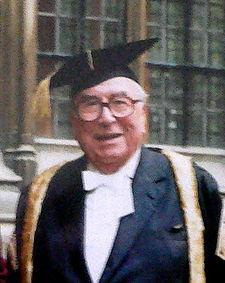 |
| 7 | Gaston Thorn Thorn Commission |
20 January 1981 | 6 January 1985 | Prime Minister |
Liberal Democrats National: Democratic Party |
 |
| 8 | Jacques Delors Delors Commission |
7 January 1985 | 24 January 1995 | Finance Minister |
Party of European Socialists National: PS |
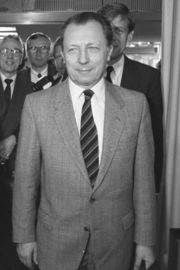 |
| 9 | Jacques Santer Santer Commission |
25 January 1995 | 15 March 1999[56] | Prime Minister |
European People's Party National: CSV |
 |
| ~ | Manuel Marín Interim Marín Commission |
15 March 1999 | 17 September 1999 | Minister for Europe |
Party of European Socialists National: PSOE |
 |
| 10 | Romano Prodi Prodi Commission |
17 September 1999 | 22 November 2004[57] | Prime Minister |
Liberal Democrats National: Democrats |
 |
| 11 | José Manuel Barroso Barroso Commission |
22 November 2004 | incumbent Term expires 31 Oct. 2014 |
Prime Minister |
European People's Party National: PSD |
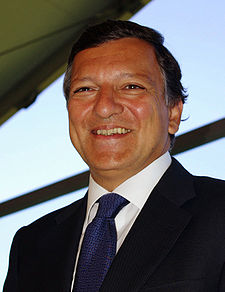 |
See also
- Vice-President of the European Commission
- European Commissioner
- List of presidents of EU institutions
- President of the European Parliament
- President of the European Council
- Presidency of the Council of the European Union
References
- Eppink, Derk-Jan; Ian Connerty (translator) (2007). Life of a European Mandarin: Inside the Commission (1st edition ed.). Tielt, Belgium: Lannoo. ISBN 978-9020970227.
Hix, Simon (2008). What's wrong with the EU and how to fix it. Cambridge, United Kingdom: Polity. ISBN 978-07456-4205-5.
Endo, Ken (1999). The Presidency of the European Commission under Jacques Delors. Basingstoke: Macmillan. ISBN 978-03337-2101-8.
- ↑ on the basis of the latest European elections
- ↑ 2.0 2.1 2.2 2.3 2.4 2.5 Hix, 2008: 155
- ↑ "European Commission". European NAvigator. http://www.ena.lu?lang=2&doc=3202. Retrieved 2007-06-18.
- ↑ Eppink, 2007, p.221-2
- ↑ 5.0 5.1 "The 'empty chair' policy". European NAvigator. http://www.ena.lu?lang=2&doc=444. Retrieved 2007-09-24.
- ↑ 6.0 6.1 Ludlow, N (2006). "De-commissioning the Empty Chair Crisis : the Community institutions and the crisis of 1965-6" (PDF). London School of Economics. http://eprints.lse.ac.uk/2422/01/Decommisioningempty.pdf. Retrieved 2007-09-24.
- ↑ Eppink, 2007, p.222
- ↑ "The Rey Commission". Europa (web portal). http://ec.europa.eu/commission_barroso/president/history/rey/index_en.htm. Retrieved 2008-02-10.
- ↑ "EU and the G8". European Commission. http://www.deljpn.ec.europa.eu/union/showpage_en_union.external.g8.php. Retrieved 2007-09-25.
- ↑ Eppink, 2007, p.222-3
- ↑ Eppink, 2007, p.24
- ↑ "The new Commission - some initial thoughts". Burson-Marsteller. 2004. http://www.bmbrussels.be/box_bmnewcomm.php. Retrieved 2007-06-17.
- ↑ Merritt, Giles (1992-01-21). "A Bit More Delors Could Revamp the Commission". International Herald Tribune. http://www.iht.com/articles/1992/01/21/edgi_0.php. Retrieved 2007-10-17.
- ↑ James, Barry (1999-04-16). "Prodi to Have Wide, New Powers as Head of the European Commission". International Herald Tribune. http://www.iht.com/articles/1999/04/16/eu.2.t_0.php. Retrieved 2007-06-17.
- ↑ Rossant, John (1999-09-27). "Commentary: Romano Prodi: Europe's First Prime Minister? (int'l edition)". Business Week. http://www.businessweek.com/1999/99_39/b3648256.htm. Retrieved 2007-06-17.
- ↑ Eppink, 2007, p.228
- ↑ Hix, 2008: 37-8
- ↑ Hix, 2008: 38
- ↑ Hix, 2008: 39
- ↑ Article 17 of the Treaty on European Union (Lisbon amended), (PDF) Eur-Lex
- ↑ Hix, 2008:157
- ↑ Hix, 2008: 158
- ↑ Hix, 2008: 159
- ↑ Cohn-Bendit, Daniel (2004). "Nomination of Commission President handled "in a most unsatisfactory way"". European Parliament. http://www.grahamwatsonmep.org/news/000025.html. Retrieved 2007-07-01.
- ↑ Watson, Graham (2004-07-21). "Statement by the President-designate of the Commission". Graham Watson MEP website. http://www.europarl.europa.eu/sides/getDoc.do?pubRef=-//EP//TEXT+CRE+20040721+ITEM-006+DOC+XML+V0//EN&language=EN. Retrieved 2007-07-01.
- ↑ "Choosing a New EU Commission President". Deutsche Welle. 2004-06-16. http://www.dw-world.de/dw/article/0,,1237192,00.html. Retrieved 2007-08-27.
- ↑ Fuller, Thimas (2004-06-30). "Portuguese premier wants to unite bloc : Barroso nominated to head EU executive". International Herald Tribune. http://www.iht.com/articles/2004/06/30/eu_ed3__5.php. Retrieved 2007-07-01.
- ↑ Stuart, Paul (2004-07-21). "Portugal’s Prime Minister Barroso nominated as European Commission president". World Socialist Web Site. http://www.wsws.org/articles/2004/jul2004/port-j21.shtml. Retrieved 2007-07-01.
- ↑ "José Manuel Durão Barroso: The New Commission President". Grayling. 2004. http://www.graylingbrussels.com/Vote4CommissionPresident/index.php?page=barossoprofile. Retrieved 2007-07-01.
- ↑ Hix, 2008:156
- ↑ Mahony, Honor (2008-02-28). "Barroso admits legitimacy problem for commission president post". EU Observer. http://euobserver.com/9/25740. Retrieved 2008-02-29.
- ↑ 32.0 32.1 Hughes, Kirsty. "Nearing Compromise as Convention goes into Final Week?" (PDF). EPIN. http://www.epin.org/pdf/comment_Hughes2_june03.pdf. Retrieved 2008-01-30.
- ↑ "European Greens Found European Greens". Deutsche Welle. 2004-02-23. http://www.dw-world.de/dw/article/0,,1119463,00.html. Retrieved 2008-01-30.
- ↑ "The EP elections: Deepening the democratic deficit". Euractiv. 2004-06-16. http://www.euractiv.com/en/future-eu/ep-elections-deepening-democratic-deficit/article-128495. Retrieved 2007-07-27.
- ↑ Mahony, Honor (2007-06-27). "European politics to get more political". EU Observer. http://euobserver.com/9/24370. Retrieved 2007-06-28.
- ↑ Palmer, John (2007-01-10). "Size shouldn't matter". The Guardian. http://commentisfree.guardian.co.uk/john_palmer/2007/01/good_rather_than_bad_not_b_ig.html. Retrieved 2007-06-28.
- ↑ "Leadership of the EU". Federal Union. http://www.federalunion.org.uk/europe/democracyleadership.shtml. Retrieved 2007-08-27.
- ↑ "RESOLUTION ELDR CONGRESS IN BERLIN 18-19 OCTOBER 2007". ELDR party. 2007-10-24. http://www.eldr.org/modules.php?name=News&file=article&sid=1127. Retrieved 2008-01-04.
- ↑ 39.0 39.1 39.2 39.3 39.4 39.5 "Role and Powers". Europa (web portal). http://ec.europa.eu/commission_barroso/president/personal/role/index_en.htm. Retrieved 2008-01-10.
- ↑ Harding, Gareth (1999-03-18). "Unfolding drama of the Commission's demise". European Voice. http://www.europeanvoice.com/archive/article.asp?id=8627. Retrieved 2007-10-07.
- ↑ "Institutions of the EU: The European Commission". Europa (web portal). http://europa.eu/institutions/inst/comm/index_en.htm. Retrieved 2007-06-18.
- ↑ Eppink, 2007, p.232-3
- ↑ Eppink, 2007, p.226-8
- ↑ Eppink, 2007, p.211-3
- ↑ Eppink, 2007, p.211
- ↑ Eppink, 2007, p.217-21
- ↑ 47.0 47.1 Rettman, Andrew (15 March 2010) Ukraine gives positive appraisal of new-model EU, EU Observer
- ↑ Iey Berry, Peter Sain (2008-01-18). "[Comment Power is slipping from the commission to the european council"]. EU Observer. http://euobserver.com/9/25484. Retrieved 2008-01-18.
- ↑ 49.0 49.1 Duff, Andrew (23 February 2010) Who is Herman Van Rompuy?
- ↑ 50.0 50.1 "A Van Barroso?". EU Observer. 15 April 2010. http://blogs.euobserver.com/mahony/2010/04/15/a-van-barroso/. Retrieved 2010-04-16.
- ↑ Hix, Simon; Roland, Gérard. "Why the Franco-German Plan would institutionalise 'cohabitation' for Europe". Foreign Policy Centre. http://fpc.org.uk/articles/201. Retrieved 2007-10-01.
- ↑ "SCADPlus: The Institutions of the Union: European Council". Europa (web portal). http://europa.eu/scadplus/constitution/europeancouncil_en.htm. Retrieved 2007-06-27.
- ↑ 53.0 53.1 53.2 REGULATION No 422/67/EEC, 5/67/EURATOM OF THE COUNCIL, EurLex
- ↑ 54.0 54.1 Base salary of grade 16, third step is €17,697.68: European Commission: Officials' salaries - accessed 19 March 2010
- ↑ Mahony, Honor (2008-04-14). "Member states consider perks and staff for new EU president". EU Observer. http://euobserver.com/9/25968. Retrieved 2008-04-15.
- ↑ Resigned early. Commission served in caretaker capacity under Marín till September. Replaced by Prodi who competed Santer's mandate to 22 January 2000 when they were reappointed on their own mandate.
- ↑ Term lasted till 31/10/04, continued as caretaker till 22/11/04 due to delay in appointment of Barroso Commission.
External links
- Commission President (official website)
- Terms of office
- Organisation of the European Commission European NAvigator
|
||||||||||||||
|
||||||||
|
|||||||||||||||

